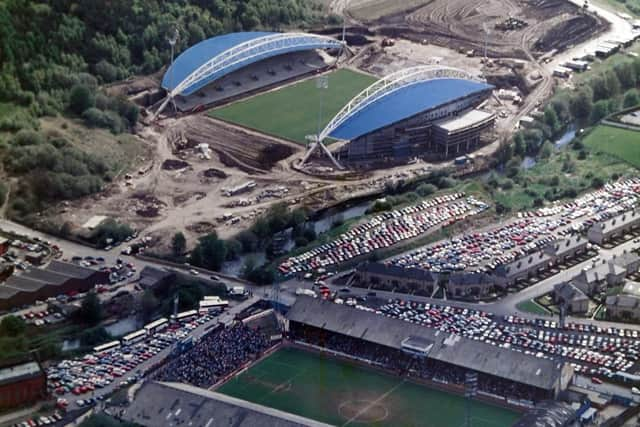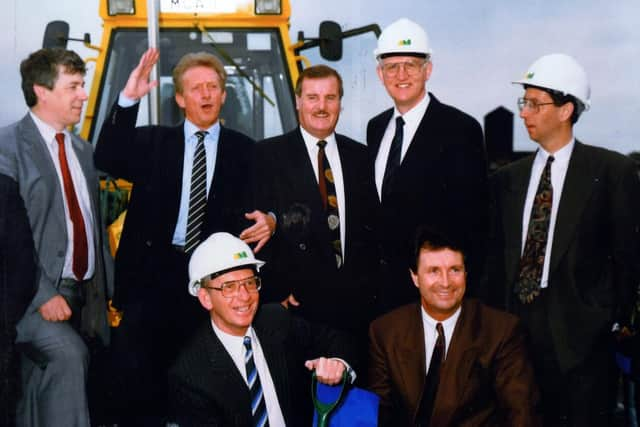Flashback - Huddersfield Town's Leeds Road gone but far from forgotten


The Terriers’ home for 86 years also had a pioneering role in the adoption of CCTV at grounds up and down the country, a notorious riot involving Leeds United hooligans leading to the first conviction in a British court using video footage.
But the sweeping changes that followed the Hillsborough disaster a little over three decades ago proved to be the death knell for a ground once packed to the rafters by a record crowd of 67,037.
Advertisement
Hide AdAdvertisement
Hide AdWith terracing on three sides, Leeds Road stood little chance of surviving at a time when famous old names such as the Holte End, Stretford End and Molineux’s South Bank crumbled to dust.
In its place came a 25,000-capacity stadium that has proved a worthy addition to the Premier League for the past two years.
George Binns, club secretary for 22 years from 1969 before heading up the team that went on to deliver the new stadium, watched his first game at Leeds Road as a six-year-old in 1942.
“Leeds Road was a special place to generations of supporters,” the 85-year-old told The Yorkshire Post ahead of Tuesday’s 30th anniversary of Huddersfield leaving their old home.
Advertisement
Hide AdAdvertisement
Hide Ad“I remember being at a Cup-tie against Newcastle in 1955 where there were 55,000 there and it was a tight squeeze, to say the least.


“Put it this way, I could not imagine them squeezing another 10,000 in there. That history, though, could only go so far.
“Leeds Road was similar to a lot of traditional grounds. It had held big crowds in the past but needed a lot of money spending to bring it up to speed.
“The Hillsborough disaster meant a big reduction in capacity. And, no matter what you did, Leeds Road was still an old ground when you had finished. We needed something for the 21st Century.”
Advertisement
Hide AdAdvertisement
Hide AdThe John Smith’s Stadium, still a hugely impressive structure a quarter-of-a-century after Town and Huddersfield Giants first moved in, is testament to that need being met.


But Terriers fans of a certain vintage still go misty-eyed at the merest mention of the Cowshed or Popular Terrace.
Nowadays, the two goalmouths where Denis Law, Frank Worthington or Ian Robins once scored goals for fun are home to a retail park.
The only concession to Huddersfield’s years of residence is a plaque in the car park outside B&Q, located on the exact site of the old centre spot. As important as it is to look forward and not back in life, it barely seems to do justice to all those decades of history.
Advertisement
Hide AdAdvertisement
Hide AdTown’s first game at Leeds Road came in 1908 but football had been played there for the best part of a decade by then. The dressing rooms were an old tramcar, the pitch ran parallel to Leeds Road and the only stand was a set of uncovered wooden bleachers.
From such inauspicious beginnings came one of Yorkshire’s great old grounds. Once the attempts to move the then debt-ridden club lock, stock and barrel to Elland Road to replace the recently disbanded Leeds City in 1919 had been seen off by a public campaign, the Leeds Road that remains etched on the memory began to take shape.
A barrel roof was installed at one end that was immediately christened the ‘Cowshed’, while all the terracing was reconstructed with crush barriers installed so strong that they still met required safety standards in the ground’s final days.
The Popular Terrace, which in its heyday held 28,000, had a giant roof added in 1955, five years after the main stand had been destroyed by fire.
Advertisement
Hide AdAdvertisement
Hide AdA replacement was built within 12 months and, crucially, made of concrete and steel. “It meant the new regulations after the Bradford fire were not a problem,” recalls former secretary Binns.
Floodlights were added in 1961, reputedly paid for by the sale of Law to Manchester City. But two pylons blew down the following year.
One initiative that did have a much more lasting impact on English football and beyond was the use of CCTV to combat hooliganism. The visit of Leeds in October, 1984, saw high-quality colour cameras posted all around the ground with the specific intention of capturing any violence.
“Leeds had a fearsome reputation and, as we had expected, serious disorder broke out,” recalls Binns. “What those ringleaders did not know is close-up video footage was being taken of them throughout the day.
Advertisement
Hide AdAdvertisement
Hide Ad“History was later made (the following December) when three fans were convicted of violence at a football ground based on video evidence. The tide was about to turn and football was fighting back against the hooligans.”
Margaret Thatcher, then Prime Minister, was so impressed with the club’s role in what led to a law stipulating all grounds in the top two divisions had to fit CCTV, she later wrote a personal letter of thanks.
Leeds Road’s last stand came on April 30, 1994, as goals from Phil Starbuck and Simon Baldry secured a 2-1 victory over Blackpool.
Binns invited Joe Walter, who had played under Herbert Chapman, to join him in the directors’ box as Town bade farewell in style before moving a few hundred yards across the River Colne.
Advertisement
Hide AdAdvertisement
Hide Ad“The ground was torn down within days,” added the former club secretary. “There was no time to hang around because the money was needed from the sale.
“Huddersfield Town had to move. People who objected were letting their hearts rule their heads. Everyone should be very proud of the magnificent stadium we have today.”
Grounds for memories
Several old grounds have bitten the dust in Yorkshire down the years, many in the wake of the Bradford and Hillsborough disasters.
Ayresome Park, a host venue in the 1966 World Cup, is now a housing estate after Middlesbrough moved out in 1995. A series of bronze sculptures mark key parts, such as a jumper and scarf where two corner flags had been.
Advertisement
Hide AdAdvertisement
Hide AdHouses also occupy sites where Boothferry Park, Hull City’s home for 56 years until 2002, and Doncaster’s Belle Vue once stood.
A supermarket can be found on Scarborough’s old Athletic Ground, while Millmoor still looks exactly as it did when Rotherham United quit 11 years ago. Park Avenue, Bradford, was abandoned in 1973, but parts still remain today, including the Horton Park End terrace.